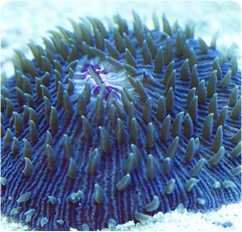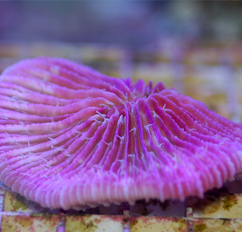|
Genus Fungia - Disk Coral
A Hardy, Colorful, Substrate-dwelling Corals
 |
| Disk Coral (Fungia) spp. |
The genus Fungia belongs to the Family Fungiidae, which is a family of non-reef building (ahermatypic) stony corals. Corals in this family are unusual looking, substrate-dwelling animals that are both interesting and relatively hardy. For the most part, they are solitary shallow water corals that, while often attached to hard substrate when young, can move about the aquarium as adults. While fairly resilient, care should be taken when selecting an aquarium specimen to match the animal’s morphology to the aquarium conditions of the tank where the coral will be placed—more on this later in the article. The common genera offered in the aquarium trade are Heliofungia, Herpolitha and the subject of this article: Fungia. Fungiids go by the common names of plate coral, disk coral, tounge coral, slipper coral, mushroom coral, fungus coral, and others.
Fungia spp.
These corals, commonly called disk corals, are difficult to identify to the species level without examining the animal’s skeleton. As such, they are usually offered as simply Fungia spp. All have a single mouth which is surrounded by tentacles that emerge from between thin skeletal plates radiating out from the mouth. They can be remarkably colorful ranging from common greens and purples to shocking pinks, purples and reds. In the wild, they tend to live in aggregations, and members of the same genus (even the same family) will not sting each other. In the aquarium, just like on the reef, they can grow very close together and carpet the substrate, which makes for a really interesting display.
Cyloseris cyclolites
Cyloseris cyclolites is a common fungiid that is not a member of the genus Fungia, but it is often mislabeled as such. It truth, it is difficult to tell the difference between these two closely related genera when the animal is young without looking at the skeleton. As adults, however, C. cyclolites remains much small (rarely more than two inches across).
Placement in the Aquaria
In terms of their morphology, species from the genus Fungia are usually flat and saucer-shaped, although they can be slightly domed. The more domed the individual specimen, the better the coral will be at purging itself of sediment. The flatter Fungia species are therefore best placed on rubble bottoms instead of sandy substrates, as soft, sandy-bottomed tanks with high flow will likely cause sediment to be deposited on the coral. Accumulated sediment can lead to stress and tissue death in Fungia spp.
Environmental Conditions & Diet
Assuming the individual specimen has been placed on the appropriate substrate, most Fungia species prefer moderate to low flow and high-intensity reef lighting. These corals do host photosynthetic symbiotic algae (zooxanthellae), but they also appreciate target feedings of meaty marine foods (they can consume some remarkably large pieces of marine flesh). In the aquarium, Fungia species may remain inflated during the day, but in the wild, they generally only inflate and feed at night. Feeding an aquarium species after the lights have gone out and the flow has been temporarily reduced is most effective.
 |
| Pink (Fungia) Species |
Other Considerations
Overall, Fungia species are disease resistant and, assuming proper handling and placement, are hardy corals. Never remove a Fungia species from the water while the coral is expanded—this will lead to tearing, infection, stress, and possibly death. Do keep in mind that these corals can move about the aquarium, and they can injure or kill other corals by secreting a mucus containing cytotoxins. As Eric Borneman writes in Aquarium Corals, “Fungia cause unilateral damage to over 94 percent of other corals by depositing thick mucus on them, causing necrosis.” Despite this dire warning, if provided with the appropriate environment, Fungia species can make great aquarium species and will generally-speaking live together with other sessile invertebrates without any issues.
Conclusion
While not the hardiest Fungiid (that honor probably goes to species from the genus Herpolitha, which also tend to have less toxic mucus), corals from the genus Fungia are fantastic aquarium animals if provided with the proper husbandry. Colorful, disease resistant and interesting to observe, these animals are recommended with enthusiasm for all aquarists from the novice to the expert.
Published 1 July 2008. © Blue Zoo Aquatics
|